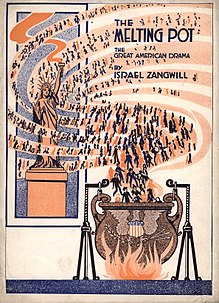Melting pot
A crucible is a crucible in which substances (mostly metals) are mixed and melted.
The metaphor "Melting Pot" was first used by Jean de Crèvecoeur in his 1782 essay Letters from an American Farmer . However, it did not become a common term until the success of the play The Melting Pot by the English writer Israel Zangwill , which premiered in Washington, DC in 1908 .
Term in the social sciences
In sociology and in political science , the term "melting pot" describes ( Engl. Melting Pot ) the assimilation and integration of immigrants to the culture of a country. The different cultures and values should blend into a common, integrated national culture. In addition to “ melting pots ”, so-called “ salad bowls ” are always to be found, in which not all cultures are merged, but immigrant groups each cultivate their own, clearly delimited cultures. This can - as practiced in Canada as a " multicultural mosaic" - be an explicit goal or it can be based on inadequate implementation of a melting pot policy.
According to the melting pot approach, assimilation and integration can create a homogeneous national culture that, despite its short roots, has a strong sense of community ; However, this approach is not free from problems: Immigrants usually experience considerable social pressure to adapt if they continue to practice their original culture in the country of immigration and if this is clearly different from the one that dominates in the country of immigration. The melting pot approach also reaches its limits when social groups do not want to be assimilated to the dominant culture.
In Germany, the easily accessible city of Cologne is seen as an example of a melting pot spanning thousands of years. During the founding period , the city of Berlin enlarged many times over; In its history, the later imperial city consisted at times largely of French, Bohemian and Austrian - mostly Protestant-Huguenot - immigrants. The state of Prussia is also seen as a multilingual melting pot, which can only be achieved through formal tolerance and economic progress, different religions (Catholicism in Silesia, Lutheran population in the old provinces and Reformed people as the ruling Hohenzollerns), different languages (German, Polish, French, Sorbian) as well as different ethnicities (Slavic ancestors, Germanic ancestors, Swiss ancestors in Neuchâtel ) could combine into one state. Carl Zuckmayer understood the Rhineland as “ Europe's mill of peoples ”. He could have taken over the idea from Wilhelm Holzamer .
The USA and Canada as a melting pot
A typical example of a “melting pot” integration strategy is the United States of America . In the course of the immigration of people from all over the world with different religions and traditions, the process already developed with the first colonies of European states and the meeting of Europeans and North American natives. In addition to the Europeans, Africans also came to America as slaves and also brought their traditions and religions with them, which, however, were suppressed by their masters and only occasionally could survive in secret. From the south there were also Hispanic groups from Cuba or Puerto Rico, as well as many Mexicans who had previously lived in the later states from California to Texas.
Due to the expansion of the trade relationship with the United States, influences from Oceania and especially the later state of Hawaii were added. From Asia, especially from China, the big railroad companies trying to build the first route through the Rocky Mountains brought in many workers. However, they were only able to live out their culture to a limited extent, as they received only a fraction of the usual wages and the working and living conditions were very harsh when building the railway. Along with the Irish, who fled their country from hunger, Italians, Germans, French, British, Scandinavians, Spaniards and Portuguese also contributed to the development of the religious and social structures of the USA.
WEB Du Bois questioned the appropriateness of the melting pot metaphor early on , with a view to the position of African Americans in the dispute with Booker T. Washington . His ideas were more in the direction of what is now called the salad bowl model : the groups retain important characteristics and behaviors and only take over a few features from neighboring groups.
Another model that is not associated with the idea of assimilation is the Canadian idea of the multicultural mosaic , which takes into account the different cultural backgrounds of the population and provides for the targeted promotion of cultural practices and languages.
Melting pot as a political myth
In the absence of a common past and origin of the immigrants, no convincing founding myth could arise in the USA. The promise of unity from and in multiplicity ( E pluribus unum ) could only have an identity-forming effect if it focused on a common future (and not on heterogeneous national traditions). This is the function of the melting pot myth criticized by Robert Putnam , which did not depict the reality of immigration and was therefore increasingly displaced by the model of the multicultural society. The New Sunbelt (the states in the southeast and southwest such as Nevada , but not California or Florida with their highly selective immigration) corresponds most closely to the melting pot model.
See also
- Völkermühle Europe (meaning the area on the Rhine , the Rhineland )
- E pluribus unum
literature
- Israel Zangwill: The Melting-Pot . Indypublish.Com, 2008, ISBN 978-1-4375-3417-7 (paperback, English).
Web links
Individual evidence
- ^ Ong, Paul M. "The Central Pacific Railroad and Exploitation of Chinese Labor." Journal of Ethnic Studies 1985 13 (2): 119-124. ISSN 0091-3219 .
- ^ Robert Putnam: E Pluribus Unum: Diversity and Community in the 21st Century. in: Scandinavian Political Studies , 30/2 (2007), pp. 137-174.
- ^ José-Antonio Orosco: Toppling the Melting Pot: Immigration and Multiculturalism in American Pragmatism. Indiana University Press 2016, p. 39 ff.
